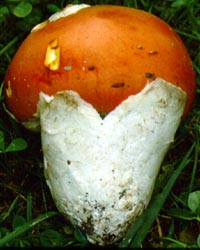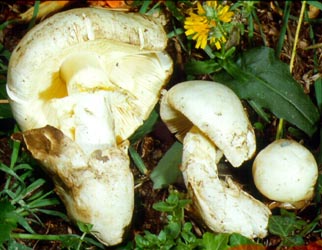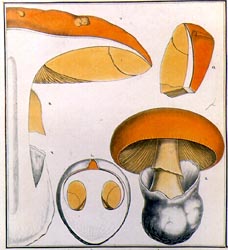|
[ Section Caesareae page. ]
[ Amanita Studies home. ]
[ Keys & Checklist/Picturebooks ] "Caesar"
Technical description t.b.d.) BRIEF DESCRIPTION: The following is based on the description by Neville and Poumarat (2004) The cap of Amanita caesarea is 50 - 140 (-190) mm wide, bright orange-red to a duller orange, often becoming more or less paler at maturity, hemispherical then plano-convex, smooth, shiny, somewhat viscid, with a rather short-striate margin (10 - 30% of the radius). The volva is present as large thick white patches. The flesh is white, yellow just below the cap skin, and 20 mm thick above the stem. The gills are free, 7 - 16 mm broad, yellow, sometimes forked at the margin, with a subflocculose margin. The short gills are attenuate to truncate, plentiful. The stem is 60 - 130 × 15 - 25 mm, cylindric or enlarging downward, yellow, smooth below the ring, and slightly striated above. The ring is ample, thick, membranous, yellow, slightly striated on the upper side, felted on the lower side. The volva is up to 60 mm tall, saccate, ample, up to 4 or 5 mm thick, connected to the stem only at the base, remote from the stem, membranous, rather tough, white on the outer surface, white or tinted orange on the inner surface except at the point of contact with the stem where it is yellow. The internal limb is placed rather high on the inner surface of the volva. The flesh is firm, stuffed in the middle with cottony material, and yellow. The spores measure (8.0-) 8.9 - 12.9 (-17.8) × (5.3-) 6.0 - 8.5 (-14.3) µm and are inamyloid and ellipsoid to elongate, occasionally broadly ellipsoid. Clamps are present at bases of the basidia. Spores measured by Neville and Poumarat (2004) are as follows: (8-) 8.5 - 12 (-14) × 6 - 8 (-9) µm and are ellipsoid to elongate, infrequently broadly ellipsoid. White and pallid specimens of this species are sometimes assigned to separate forma (A. caesarea f. alba (Gillet) E.-J. Gilbert). My correspondents tell me that white fruiting bodies are only found among pigmented ones. Hence, it seems probable they all arise from the same hymenium; and there is no need to create a separate taxon.< Amanita caesarea is a species of the Mediterranean Region, where it is a widely desired edible. In the Americas there are very similar sister species known primarily from Mexico (one from the eastern US lacks the bright colors common to the others); together with A. caesarea, they form a distinct taxonomic group -- stirps Caesarea. While it has not yet been proven or disproven that all species of section Vaginatae with rings have a common ancestor, it seems to be the case that the group of taxa with great similarity to Amanita hemibapha (Berk. & Broome) Sacc. (stirps Hemibapha) do indeed have a common ancestor with stirps Caesarea -- based on both macroscopic and microscopic morphological evidence--primarily by having (1) similar subhymenia that suggests plant tissue due to being composed of inflated cells; (2) the frequent appearances of red, orange, and yellow as dominant colors; (3) the presence of a felted internal limb of the volva (fragments of which decorate the stem at maturity); (4) spores that are usually broadly ellipsoid to elongate; and (5) temperate to tropic distribution). To date, molecular evidence is also supportive of the hypothesis of a common ancestor. An example of the Mexican cluster is Amanita basii Guzmán & Ramírez-Guillén (2001), like its European sister, it is a "market species." The authors of the latter species named four other species that they assigned to stirps Caesarea in the same publication in which A. basii was described. One of these, A. tullossii Guzmán & Ramírez-Guillén, is a misdetermination (see A. jacksonii Pomerleau). Of the remaining three names, A. laurae Guzmán & Ramírez-Guillén appears to be distinct, and the last two names, A. yema Guzmán & Ramírez-Guillén and A. tecomate Guzmán & Ramírez-Guillén appear to be synonyms. The species in stirps Caesarea known from the eastern USA is A. spreta (Peck) Sacc. Hence, in stirps Caesarea there are five known taxa, one in the old world, and four in the new. This is in contrast to the growing number of recognized taxa in stirps Hemibapha, which will surely soon exceed forty. This disparity along with the comparatively limited distribution of stirps Caesarea suggest that the members of the stirps comprise a relictual group. The reader may also wish to follow up by referencing stirps Calyptroderma. -- R. E. Tulloss Photos: R. Le Tourneau (top left, France); Dr. Mido Traverso (top right, Italy); Ingr.
Carmine Lavorato (middle left, Italy); Francis Massart (bottom, France).
[ Section Caesareae page. ]
[ Amanita Studies home. ]
[ Keys & Checklist/Picturebooks ] Last changed 30 September 2009. |




